Company Details
servicenow
30,443
1,381,149
5112
http://www.servicenow.com
0
SER_2788753
In-progress

ServiceNow Company CyberSecurity Posture
http://www.servicenow.comServiceNow (NYSE: NOW) makes the world work better for everyone. Our cloud-based platform and solutions help digitize and unify organizations so that they can find smarter, faster, better ways to make work flow. So employees and customers can be more connected, more innovative, and more agile. And we can all create the future we imagine. The world works with ServiceNow. For more information, visit www.servicenow.com.
Company Details
servicenow
30,443
1,381,149
5112
http://www.servicenow.com
0
SER_2788753
In-progress
Between 800 and 849

 ServiceNow Global Score (TPRM)
ServiceNow Global Score (TPRM)XXXX

Description: A new vulnerability in ServiceNow, dubbed Count(er) Strike, allows low-privileged users to extract sensitive data from tables to which they should not have access. The flaw, discovered by Varonis Threat Labs in February 2025 and assigned the CVE-2025-3648 identifier, impacts configurations with misconfigured or overly permissive ACLs. This vulnerability could lead to the leakage of sensitive data, including credentials, PII, and internal configuration data, potentially affecting various industries using ServiceNow, such as public sector organizations, healthcare, financial institutions, and large enterprises.


ServiceNow has 127.27% more incidents than the average of same-industry companies with at least one recorded incident.
ServiceNow has 56.25% more incidents than the average of all companies with at least one recorded incident.
ServiceNow reported 1 incidents this year: 0 cyber attacks, 0 ransomware, 1 vulnerabilities, 0 data breaches, compared to industry peers with at least 1 incident.
ServiceNow cyber incidents detection timeline including parent company and subsidiaries

ServiceNow (NYSE: NOW) makes the world work better for everyone. Our cloud-based platform and solutions help digitize and unify organizations so that they can find smarter, faster, better ways to make work flow. So employees and customers can be more connected, more innovative, and more agile. And we can all create the future we imagine. The world works with ServiceNow. For more information, visit www.servicenow.com.


Cox Automotive is the world’s largest automotive services and technology provider. Fueled by the largest breadth of first-party data fed by 2.3 billion online interactions a year, Cox Automotive tailors leading solutions for car shoppers, auto manufacturers, dealers, lenders and fleets. The company

Every company has a mission. What's ours? To empower every person and every organization to achieve more. We believe technology can and should be a force for good and that meaningful innovation contributes to a brighter world in the future and today. Our culture doesn’t just encourage curiosity; it
We help those who build the future to make it amazing. In an era where new technologies are born every minute, and the demand for meaningful digital experiences has never been so intense, we unlock our customers’ innovative potential, empowering them to transform their boldest ideas into reality, an

GlobalLogic, a Hitachi Group company, is a trusted partner in design, data, and digital engineering for the world’s largest and most innovative companies. Since our inception in 2000, we have been at the forefront of the digital revolution, helping to create some of the most widely used digital prod

**Snowflake is proud to be the Official Data Collaboration Provider for LA28 and Team USA.** Snowflake delivers the AI Data Cloud — a global network where thousands of organizations mobilize data with near-unlimited scale, concurrency, and performance. Inside the AI Data Cloud, organizations unite

Adhering to the ‘Retail + Technology’ strategy, Meituan commits to its mission that 'We help people eat better, live better'. Since its establishment in March 2010, Meituan has advanced the digital upgrading of services and goods retail on both supply and demand sides. Together with our partners we
Juniper Networks is leading the revolution in networking, making it one of the most exciting technology companies in Silicon Valley today. Since being founded by Pradeep Sindhu, Dennis Ferguson, and Bjorn Liencres nearly 20 years ago, Juniper’s sole mission has been to create innovative products and

Cisco is the worldwide technology leader that is revolutionizing the way organizations connect and protect in the AI era. For more than 40 years, Cisco has securely connected the world. With its industry leading AI-powered solutions and services, Cisco enables its customers, partners and communities
SAP is the leading enterprise application and business AI company. We stand at the intersection of business and technology, where our innovations are designed to directly address real business challenges and produce real-world impacts. Our solutions are the backbone for the world’s most complex and
.png)
Researcher found a flaw in ServiceNow's Now Assist AI, attackers use a second-order prompt-injection attack of default agent settings.
In the rapidly evolving landscape of enterprise AI, ServiceNow's Now Assist platform has emerged as a powerhouse for automating workflows...
Security researchers have uncovered a critical vulnerability in ServiceNow's Now Assist AI platform that enables attackers to execute...
Synechron, a New York-headquartered IT consulting firm, has acquired Boston-based ServiceNow specialist RapDev, alongside two other...
Cybersecurity firm Oneleet secures $33m Series A led by Dawn Capital. Discover how it aims to end compliance theatre—read more now.
With Coreio, Blue Mantis adds Canadian market presence, nearshore delivery, and deeper ServiceNow capabilities to support midmarket...
Best Cybersecurity Compliance Management Software : 1. Vanta 2. Hyperproof 3. Drata 4. Tugboat Logic 5. OneTrust 6. IBM OpenPages.
Former Walt Disney cybersecurity lead Tirthankar Dutta has transitioned from the enterprise side to the solutions space, joining ServiceNow as...
ServiceNow Appoints Tirthankar Dutta as Director & Head – Cybersecurity Engineering & AI Automation ... ServiceNow has appointed Tirthankar Dutta...

Explore insights on cybersecurity incidents, risk posture, and Rankiteo's assessments.
The official website of ServiceNow is http://www.servicenow.com.
According to Rankiteo, ServiceNow’s AI-generated cybersecurity score is 831, reflecting their Good security posture.
According to Rankiteo, ServiceNow currently holds 0 security badges, indicating that no recognized compliance certifications are currently verified for the organization.
According to Rankiteo, ServiceNow is not certified under SOC 2 Type 1.
According to Rankiteo, ServiceNow does not hold a SOC 2 Type 2 certification.
According to Rankiteo, ServiceNow is not listed as GDPR compliant.
According to Rankiteo, ServiceNow does not currently maintain PCI DSS compliance.
According to Rankiteo, ServiceNow is not compliant with HIPAA regulations.
According to Rankiteo,ServiceNow is not certified under ISO 27001, indicating the absence of a formally recognized information security management framework.
ServiceNow operates primarily in the Software Development industry.
ServiceNow employs approximately 30,443 people worldwide.
ServiceNow presently has no subsidiaries across any sectors.
ServiceNow’s official LinkedIn profile has approximately 1,381,149 followers.
ServiceNow is classified under the NAICS code 5112, which corresponds to Software Publishers.
No, ServiceNow does not have a profile on Crunchbase.
Yes, ServiceNow maintains an official LinkedIn profile, which is actively utilized for branding and talent engagement, which can be accessed here: https://www.linkedin.com/company/servicenow.
As of November 27, 2025, Rankiteo reports that ServiceNow has experienced 1 cybersecurity incidents.
ServiceNow has an estimated 26,608 peer or competitor companies worldwide.
Incident Types: The types of cybersecurity incidents that have occurred include Vulnerability.
Detection and Response: The company detects and responds to cybersecurity incidents through an containment measures with introducing 'deny unless' acls, adding query acls, recommending the use of security data filters, and remediation measures with manually review tables and modify acls to ensure they are not overly permissive..
Title: Count(er) Strike Vulnerability in ServiceNow
Description: A new vulnerability in ServiceNow, dubbed Count(er) Strike, allows low-privileged users to extract sensitive data from tables to which they should not have access. The flaw was discovered by Varonis Threat Labs in February 2025 and assigned the CVE-2025-3648 identifier.
Date Detected: February 2025
Type: Vulnerability Exploitation
Attack Vector: Misconfigured or overly permissive ACLs
Vulnerability Exploited: CVE-2025-3648
Motivation: Data Exfiltration
Common Attack Types: The most common types of attacks the company has faced is Vulnerability.
Identification of Attack Vectors: The company identifies the attack vectors used in incidents through Misconfigured or overly permissive ACLs.

Data Compromised: Sensitive data, credentials, PII, internal configuration data
Systems Affected: ServiceNow ITSM product and potentially all ServiceNow products utilizing the same ACL logic
Commonly Compromised Data Types: The types of data most commonly compromised in incidents are Sensitive data, credentials, PII and internal configuration data.

Entity Name: ServiceNow
Entity Type: Company
Industry: Cloud-based Platform
Customers Affected: Public sector organizations, Healthcare, Financial institutions, Large enterprises

Containment Measures: Introducing 'Deny Unless' ACLs, Adding Query ACLs, Recommending the use of Security Data Filters
Remediation Measures: Manually review tables and modify ACLs to ensure they are not overly permissive

Type of Data Compromised: Sensitive data, credentials, PII, internal configuration data
Data Exfiltration: Enumeration of data records from a table
Personally Identifiable Information: PII
Prevention of Data Exfiltration: The company takes the following measures to prevent data exfiltration: Manually review tables and modify ACLs to ensure they are not overly permissive.
Handling of PII Incidents: The company handles incidents involving personally identifiable information (PII) through by introducing 'deny unless' acls, adding query acls and recommending the use of security data filters.

Lessons Learned: Importance of reviewing and properly configuring ACLs to prevent unauthorized access

Recommendations: Use 'Deny Unless' ACLs, Query ACLs, and Security Data Filters to mitigate similar vulnerabilities
Key Lessons Learned: The key lessons learned from past incidents are Importance of reviewing and properly configuring ACLs to prevent unauthorized access.
Implemented Recommendations: The company has implemented the following recommendations to improve cybersecurity: Use 'Deny Unless' ACLs, Query ACLs and and Security Data Filters to mitigate similar vulnerabilities.

Source: Varonis Threat Labs
Additional Resources: Stakeholders can find additional resources on cybersecurity best practices at and Source: Varonis Threat Labs.

Entry Point: Misconfigured or overly permissive ACLs

Root Causes: Misconfigured or overly permissive ACLs
Corrective Actions: Review and modify ACLs to ensure they are not overly permissive
Corrective Actions Taken: The company has taken the following corrective actions based on post-incident analysis: Review and modify ACLs to ensure they are not overly permissive.
Most Recent Incident Detected: The most recent incident detected was on February 2025.
Most Significant Data Compromised: The most significant data compromised in an incident were Sensitive data, credentials, PII and internal configuration data.
Containment Measures in Most Recent Incident: The containment measures taken in the most recent incident were Introducing 'Deny Unless' ACLs, Adding Query ACLs and Recommending the use of Security Data Filters.
Most Sensitive Data Compromised: The most sensitive data compromised in a breach were Sensitive data, credentials, PII and internal configuration data.
Most Significant Lesson Learned: The most significant lesson learned from past incidents was Importance of reviewing and properly configuring ACLs to prevent unauthorized access.
Most Significant Recommendation Implemented: The most significant recommendation implemented to improve cybersecurity was Use 'Deny Unless' ACLs, Query ACLs and and Security Data Filters to mitigate similar vulnerabilities.
Most Recent Source: The most recent source of information about an incident is Varonis Threat Labs.
Most Recent Entry Point: The most recent entry point used by an initial access broker was an Misconfigured or overly permissive ACLs.
.png)
Angular is a development platform for building mobile and desktop web applications using TypeScript/JavaScript and other languages. Prior to versions 19.2.16, 20.3.14, and 21.0.1, there is a XSRF token leakage via protocol-relative URLs in angular HTTP clients. The vulnerability is a Credential Leak by App Logic that leads to the unauthorized disclosure of the Cross-Site Request Forgery (XSRF) token to an attacker-controlled domain. Angular's HttpClient has a built-in XSRF protection mechanism that works by checking if a request URL starts with a protocol (http:// or https://) to determine if it is cross-origin. If the URL starts with protocol-relative URL (//), it is incorrectly treated as a same-origin request, and the XSRF token is automatically added to the X-XSRF-TOKEN header. This issue has been patched in versions 19.2.16, 20.3.14, and 21.0.1. A workaround for this issue involves avoiding using protocol-relative URLs (URLs starting with //) in HttpClient requests. All backend communication URLs should be hardcoded as relative paths (starting with a single /) or fully qualified, trusted absolute URLs.
Forge (also called `node-forge`) is a native implementation of Transport Layer Security in JavaScript. An Uncontrolled Recursion vulnerability in node-forge versions 1.3.1 and below enables remote, unauthenticated attackers to craft deep ASN.1 structures that trigger unbounded recursive parsing. This leads to a Denial-of-Service (DoS) via stack exhaustion when parsing untrusted DER inputs. This issue has been patched in version 1.3.2.
Forge (also called `node-forge`) is a native implementation of Transport Layer Security in JavaScript. An Integer Overflow vulnerability in node-forge versions 1.3.1 and below enables remote, unauthenticated attackers to craft ASN.1 structures containing OIDs with oversized arcs. These arcs may be decoded as smaller, trusted OIDs due to 32-bit bitwise truncation, enabling the bypass of downstream OID-based security decisions. This issue has been patched in version 1.3.2.
Suricata is a network IDS, IPS and NSM engine developed by the OISF (Open Information Security Foundation) and the Suricata community. Prior to versions 7.0.13 and 8.0.2, working with large buffers in Lua scripts can lead to a stack overflow. Users of Lua rules and output scripts may be affected when working with large buffers. This includes a rule passing a large buffer to a Lua script. This issue has been patched in versions 7.0.13 and 8.0.2. A workaround for this issue involves disabling Lua rules and output scripts, or making sure limits, such as stream.depth.reassembly and HTTP response body limits (response-body-limit), are set to less than half the stack size.
Suricata is a network IDS, IPS and NSM engine developed by the OISF (Open Information Security Foundation) and the Suricata community. In versions from 8.0.0 to before 8.0.2, a NULL dereference can occur when the entropy keyword is used in conjunction with base64_data. This issue has been patched in version 8.0.2. A workaround involves disabling rules that use entropy in conjunction with base64_data.

Get company history
















Every week, Rankiteo analyzes billions of signals to give organizations a sharper, faster view of emerging risks. With deeper, more actionable intelligence at their fingertips, security teams can outpace threat actors, respond instantly to Zero-Day attacks, and dramatically shrink their risk exposure window.
Identify exposed access points, detect misconfigured SSL certificates, and uncover vulnerabilities across the network infrastructure.
Gain visibility into the software components used within an organization to detect vulnerabilities, manage risk, and ensure supply chain security.
Monitor and manage all IT assets and their configurations to ensure accurate, real-time visibility across the company's technology environment.
Leverage real-time insights on active threats, malware campaigns, and emerging vulnerabilities to proactively defend against evolving cyberattacks.




